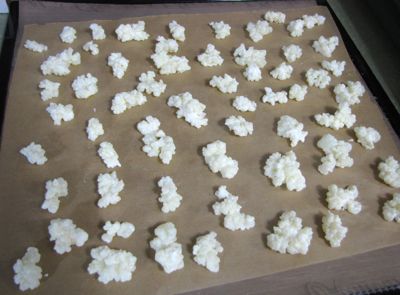How to freeze or dehydrate Kefir
Once you have been brewing Kefir for a while you will soon have more grains than you know what to do with, one of the most commonly asked questions we have is "what do i do with all these grains?" .......
i recommend once you have enough grains it is always best to have a back up set of grains either dehydrated or frozen. Then if for some unexpected reason you loose your grains, all is not lost you just grab your spares.
There are two ways to keep grains long term, both of these methods will keep grains for about 12 months. After that the failure rate when you restore the grains increases so its best to replace your back up grains after the 12 months to avoid your back up grains becoming unviable.
HOW TO DEHYDRATE OR DRY OUT GRAINS. (The same method can be used for water or milk grains)

Equipment needed:
** 3 x Ironed Tea Towels (they need to have been freshly laundered and the ironed with a REALLY hot iron for quite some time to make sure that there are no rogue bacteria etc. lurking in there.) or grease proof paper
**Grains (milk or water)
**Zip lock freezer bags or similar
- Take some of your grains and give them a really good rinse in filtered unchlorinated water.
- Place them in one of the ironed tea towels and gently squeeze to remove as much moisture as possible (gently though! you do not want to squish or damage the grains).
- Place a new ironed tea towel on a plate or some other flat surface, gently spread out the grains. Try to smooth out any clusters so that they are spread as thinly as possible.
- Place the other Ironed tea towel over the top of the grains.
- Leave to dry out somewhere they are not likely to be contaminated, so you need it to be somewhere that is not in a high traffic area of your home and i would avoid kitchens and laundry rooms unless you are able to pop them in a cupboard. The room should not be too hot or too cold as this will affect how the grains dry out.
- The drying process generally takes 3-5 days. In general water grains take longer to dry than milk grains. The water grains will look rather like brown sugar or sand when dried and the milk grains will have shrunk considerably and will be much more yellow in colour.
- once the grains are dry pop them in the zip lock bag and squeeze as much of the air out as possible and store somewhere cool and dry.
HOW TO FREEZE KEFIR GRAINS. (The same method can be used for water or milk grains)
Equipment needed:
** 3 x Ironed Tea Towels (they need to have been freshly laundered and the ironed with a REALLY hot iron for quite some time to make sure that there are no rogue bacteria etc. lurking in there.)
**Grains (milk or water)
**Zip lock freezer bags or similar
**Dried milk powder if you are freezing milk kefir grains (this is optional)
Follow steps 1 to 3 from above then
- leave the grains to dry out slightly for 12-24 hours. This is to stop water crystals damaging the grains when they are frozen
- place the grains in a zip lock bag (if you are freezing milk grains we find that covering the grains with milk powder in the zip lock bag helps to avoid freezer burn but this is optional)
- seal the bag and place the grains in the freezer.
- The grains should remain viable for up to 12 months.
To use the grains simply remove from the freezer, allow to defrost and then brew as normal.
